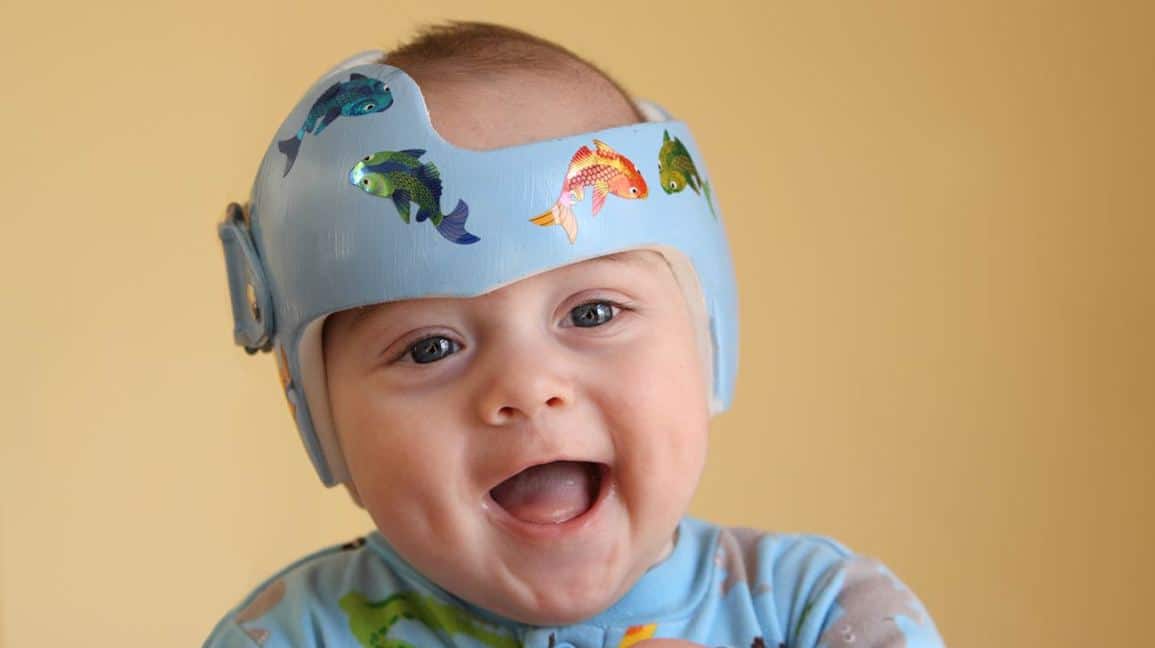You may be walking in a mall or visiting a local park and see a child wearing a helmet. As a parent or nanny, you may wonder why and when infants need a medically prescribed helmet to correct a shape deformity.
The skull of a baby is made up of several malleable plates with soft spots (called fontanels) and ridges (called sutures). These are areas where the cranial bones have not yet fused together. This soft skull serves multiple purposes including allowing the baby to pass through the birth canal and creating space for rapid brain growth during the first years of life. Over time, the bones in the skull fuse together. However, while their skulls are still soft, they may develop irregularly shaped heads.
Many babies get flat head syndrome. This occurs when one of the soft plates of the baby’s head flattens. When the head becomes flattened on one side it is called positional plagiocephaly. When the whole back of the head becomes flattened causing it to widen it is called brachycephaly. These conditions are not dangerous to a baby’s brain or development. These issues tend to occur to babies who spend a lot of time in one position, such as on their back.
As with all medical conditions, the baby’s parents must consult with their pediatrician if they have concerns over the shape of the baby’s head. Many times, conservative treatments such as repositioning and physical therapy are tried and prove successful. If other treatments fail to correct the issue, the baby may have to wear a specialized helmet called a cranial orthosis. It is important to note that not all infants are good candidates for helmet therapy, and the parents must consult with the child’s doctor to determine the best course of treatment for their baby
A cranial orthosis is made with a hard-exterior shell and a softer interior that applies gentle, consistent pressure to specific parts of the head. The pressure areas inhibit growth in prominent areas while allowing growth in the flatter regions. In this way, the baby’s head can grow and change naturally as each helmet is custom fit to the child. The helmets are designed to reshape the skull and adjustments must be made frequently as the baby’s head grows. These helmets are NOT designed to protect the head from injury.
A more serious condition may also warrant the need for a cranial orthosis. Some babies are born with a birth defect that causes the bones in the skull to fuse too early (craniosynostosis). This results in abnormal skull shape and restricts brain growth. Craniosynostosis is corrected by cranial surgery and, many times, a post-operative helmet.
If a baby has to wear a helmet, it is important that they wear it all the time. In general, the only time the helmet is removed is for bathing and dressing. While this may seem like overkill, a baby’s skull is only soft and malleable for a short period of time and the helmet can only work during this period. To get maximum benefit, the helmet should be worn 23 hours a day so it can shape the head properly before the bones are fused. Helmets are not effective once the bones have fused.
A properly fitted helmet should not be uncomfortable for the baby. If the helmet is not positioned properly, skin irritation may occur. If this happens, check with the doctor to adjust. Skin irritations should not be accepted as a normal side effect of the treatment. Also, the helmet must be thoroughly cleaned and maintained so that it does not develop any bad odors.
A cranial orthosis is not required for every baby with a misshapen head. In fact, they are the exception and not the rule. In cases of craniosynostosis requiring surgery, the use of the cranial orthosis may be a key part of the total treatment.
For more information:
Nannies can learn more about this and other infant care issues in the Advanced Newborn Care course within the Advanced Childcare training program at the Nanny Institute.


Babies usually wear their helmets for 23 hours each day. Most children quickly get used to wearing them. The helmet should be taken off when it’s time for your baby’s bath. It should be cleaned at that time. Problems such as skin irritation, discomfort, and bad odor should not occur. If there are problems, the helmet should be adjusted by the specialist who made it.